RMIT Supply Chain Management: Drivers of Competitive Advantage Report
VerifiedAdded on 2022/09/15
|14
|3380
|30
Report
AI Summary
This report examines the drivers of competitive advantage in supply chain management, drawing upon Mentzer's work and other research. It begins by summarizing twelve key drivers, including aligning reward structures, collaborating with partners, leveraging information systems, and prioritizing customer satisfaction. For each driver, the report discusses its suitability in various contexts, providing examples of industries and scenarios where the strategy is effective or less applicable. The report also highlights demand management and collaboration strategies. The report further analyzes the importance of strategies in the context of supply chain responsiveness. This report offers valuable insights for students and professionals seeking to understand and improve supply chain performance and gain competitive advantage.

Supply Chain Drivers 1
Supply Chain Drivers
By (Name)
Course
Professor’s Name
Institution
Date
Supply Chain Drivers
By (Name)
Course
Professor’s Name
Institution
Date
Paraphrase This Document
Need a fresh take? Get an instant paraphrase of this document with our AI Paraphraser
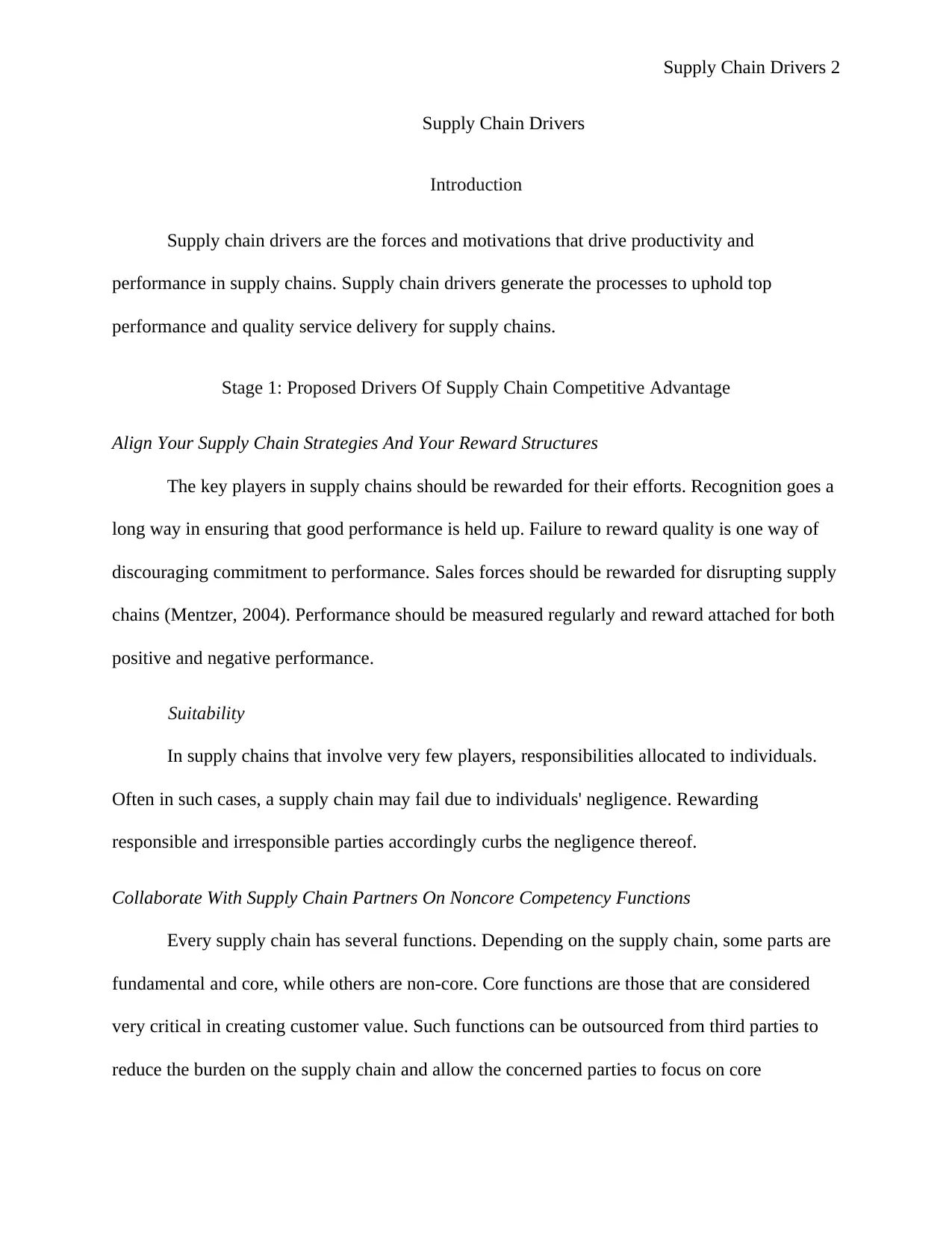
Supply Chain Drivers 2
Supply Chain Drivers
Introduction
Supply chain drivers are the forces and motivations that drive productivity and
performance in supply chains. Supply chain drivers generate the processes to uphold top
performance and quality service delivery for supply chains.
Stage 1: Proposed Drivers Of Supply Chain Competitive Advantage
Align Your Supply Chain Strategies And Your Reward Structures
The key players in supply chains should be rewarded for their efforts. Recognition goes a
long way in ensuring that good performance is held up. Failure to reward quality is one way of
discouraging commitment to performance. Sales forces should be rewarded for disrupting supply
chains (Mentzer, 2004). Performance should be measured regularly and reward attached for both
positive and negative performance.
Suitability
In supply chains that involve very few players, responsibilities allocated to individuals.
Often in such cases, a supply chain may fail due to individuals' negligence. Rewarding
responsible and irresponsible parties accordingly curbs the negligence thereof.
Collaborate With Supply Chain Partners On Noncore Competency Functions
Every supply chain has several functions. Depending on the supply chain, some parts are
fundamental and core, while others are non-core. Core functions are those that are considered
very critical in creating customer value. Such functions can be outsourced from third parties to
reduce the burden on the supply chain and allow the concerned parties to focus on core
Supply Chain Drivers
Introduction
Supply chain drivers are the forces and motivations that drive productivity and
performance in supply chains. Supply chain drivers generate the processes to uphold top
performance and quality service delivery for supply chains.
Stage 1: Proposed Drivers Of Supply Chain Competitive Advantage
Align Your Supply Chain Strategies And Your Reward Structures
The key players in supply chains should be rewarded for their efforts. Recognition goes a
long way in ensuring that good performance is held up. Failure to reward quality is one way of
discouraging commitment to performance. Sales forces should be rewarded for disrupting supply
chains (Mentzer, 2004). Performance should be measured regularly and reward attached for both
positive and negative performance.
Suitability
In supply chains that involve very few players, responsibilities allocated to individuals.
Often in such cases, a supply chain may fail due to individuals' negligence. Rewarding
responsible and irresponsible parties accordingly curbs the negligence thereof.
Collaborate With Supply Chain Partners On Noncore Competency Functions
Every supply chain has several functions. Depending on the supply chain, some parts are
fundamental and core, while others are non-core. Core functions are those that are considered
very critical in creating customer value. Such functions can be outsourced from third parties to
reduce the burden on the supply chain and allow the concerned parties to focus on core
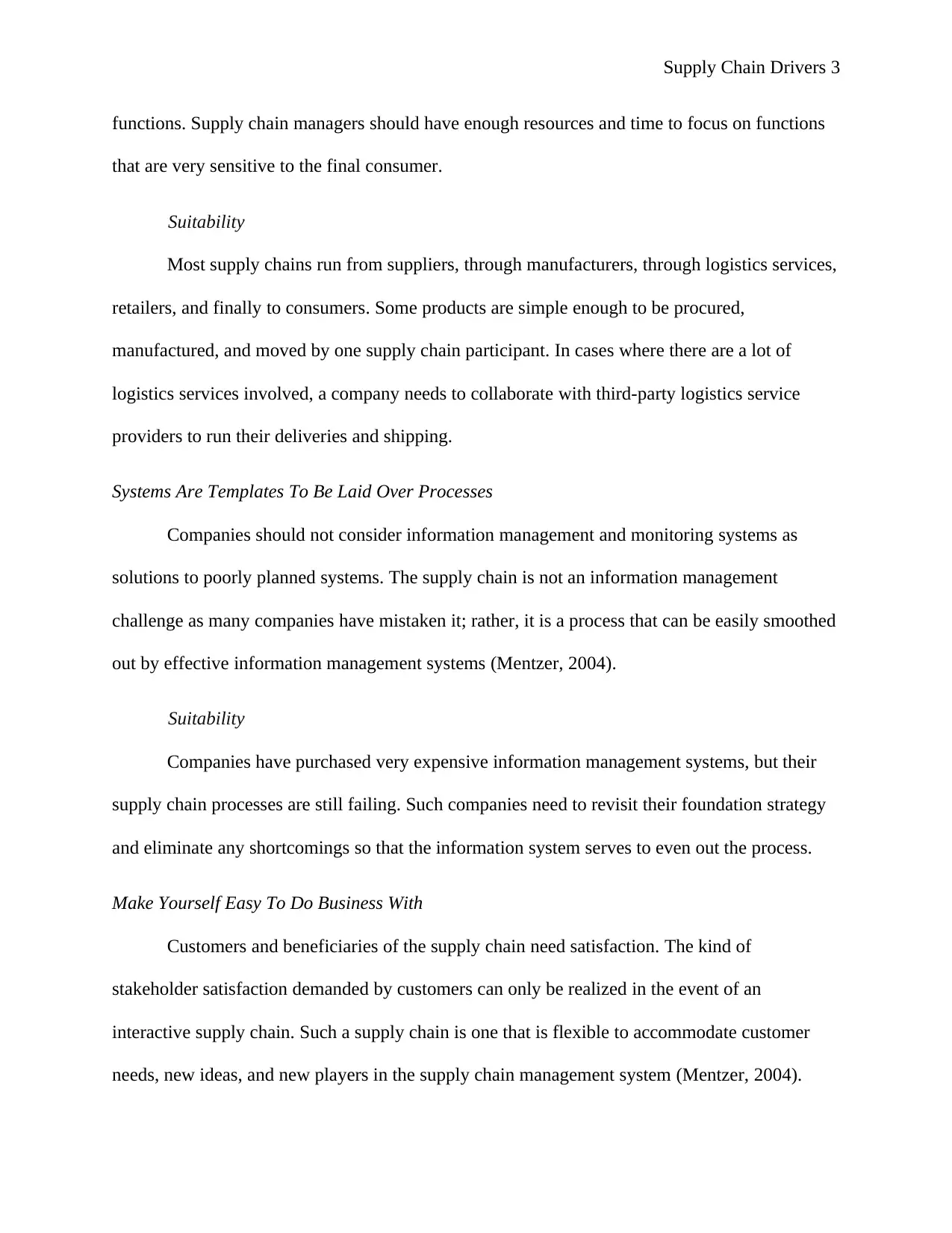
Supply Chain Drivers 3
functions. Supply chain managers should have enough resources and time to focus on functions
that are very sensitive to the final consumer.
Suitability
Most supply chains run from suppliers, through manufacturers, through logistics services,
retailers, and finally to consumers. Some products are simple enough to be procured,
manufactured, and moved by one supply chain participant. In cases where there are a lot of
logistics services involved, a company needs to collaborate with third-party logistics service
providers to run their deliveries and shipping.
Systems Are Templates To Be Laid Over Processes
Companies should not consider information management and monitoring systems as
solutions to poorly planned systems. The supply chain is not an information management
challenge as many companies have mistaken it; rather, it is a process that can be easily smoothed
out by effective information management systems (Mentzer, 2004).
Suitability
Companies have purchased very expensive information management systems, but their
supply chain processes are still failing. Such companies need to revisit their foundation strategy
and eliminate any shortcomings so that the information system serves to even out the process.
Make Yourself Easy To Do Business With
Customers and beneficiaries of the supply chain need satisfaction. The kind of
stakeholder satisfaction demanded by customers can only be realized in the event of an
interactive supply chain. Such a supply chain is one that is flexible to accommodate customer
needs, new ideas, and new players in the supply chain management system (Mentzer, 2004).
functions. Supply chain managers should have enough resources and time to focus on functions
that are very sensitive to the final consumer.
Suitability
Most supply chains run from suppliers, through manufacturers, through logistics services,
retailers, and finally to consumers. Some products are simple enough to be procured,
manufactured, and moved by one supply chain participant. In cases where there are a lot of
logistics services involved, a company needs to collaborate with third-party logistics service
providers to run their deliveries and shipping.
Systems Are Templates To Be Laid Over Processes
Companies should not consider information management and monitoring systems as
solutions to poorly planned systems. The supply chain is not an information management
challenge as many companies have mistaken it; rather, it is a process that can be easily smoothed
out by effective information management systems (Mentzer, 2004).
Suitability
Companies have purchased very expensive information management systems, but their
supply chain processes are still failing. Such companies need to revisit their foundation strategy
and eliminate any shortcomings so that the information system serves to even out the process.
Make Yourself Easy To Do Business With
Customers and beneficiaries of the supply chain need satisfaction. The kind of
stakeholder satisfaction demanded by customers can only be realized in the event of an
interactive supply chain. Such a supply chain is one that is flexible to accommodate customer
needs, new ideas, and new players in the supply chain management system (Mentzer, 2004).
⊘ This is a preview!⊘
Do you want full access?
Subscribe today to unlock all pages.

Trusted by 1+ million students worldwide
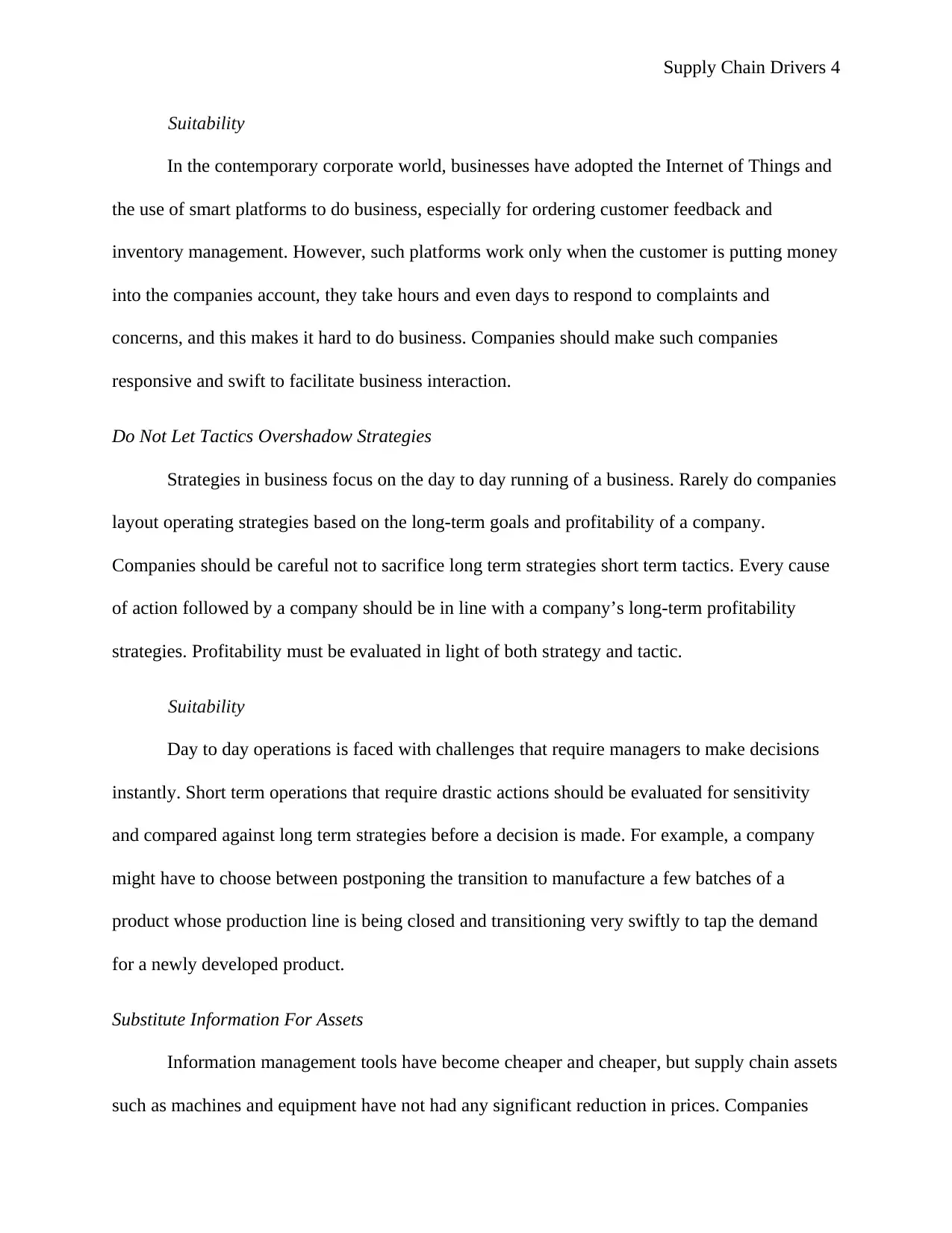
Supply Chain Drivers 4
Suitability
In the contemporary corporate world, businesses have adopted the Internet of Things and
the use of smart platforms to do business, especially for ordering customer feedback and
inventory management. However, such platforms work only when the customer is putting money
into the companies account, they take hours and even days to respond to complaints and
concerns, and this makes it hard to do business. Companies should make such companies
responsive and swift to facilitate business interaction.
Do Not Let Tactics Overshadow Strategies
Strategies in business focus on the day to day running of a business. Rarely do companies
layout operating strategies based on the long-term goals and profitability of a company.
Companies should be careful not to sacrifice long term strategies short term tactics. Every cause
of action followed by a company should be in line with a company’s long-term profitability
strategies. Profitability must be evaluated in light of both strategy and tactic.
Suitability
Day to day operations is faced with challenges that require managers to make decisions
instantly. Short term operations that require drastic actions should be evaluated for sensitivity
and compared against long term strategies before a decision is made. For example, a company
might have to choose between postponing the transition to manufacture a few batches of a
product whose production line is being closed and transitioning very swiftly to tap the demand
for a newly developed product.
Substitute Information For Assets
Information management tools have become cheaper and cheaper, but supply chain assets
such as machines and equipment have not had any significant reduction in prices. Companies
Suitability
In the contemporary corporate world, businesses have adopted the Internet of Things and
the use of smart platforms to do business, especially for ordering customer feedback and
inventory management. However, such platforms work only when the customer is putting money
into the companies account, they take hours and even days to respond to complaints and
concerns, and this makes it hard to do business. Companies should make such companies
responsive and swift to facilitate business interaction.
Do Not Let Tactics Overshadow Strategies
Strategies in business focus on the day to day running of a business. Rarely do companies
layout operating strategies based on the long-term goals and profitability of a company.
Companies should be careful not to sacrifice long term strategies short term tactics. Every cause
of action followed by a company should be in line with a company’s long-term profitability
strategies. Profitability must be evaluated in light of both strategy and tactic.
Suitability
Day to day operations is faced with challenges that require managers to make decisions
instantly. Short term operations that require drastic actions should be evaluated for sensitivity
and compared against long term strategies before a decision is made. For example, a company
might have to choose between postponing the transition to manufacture a few batches of a
product whose production line is being closed and transitioning very swiftly to tap the demand
for a newly developed product.
Substitute Information For Assets
Information management tools have become cheaper and cheaper, but supply chain assets
such as machines and equipment have not had any significant reduction in prices. Companies
Paraphrase This Document
Need a fresh take? Get an instant paraphrase of this document with our AI Paraphraser
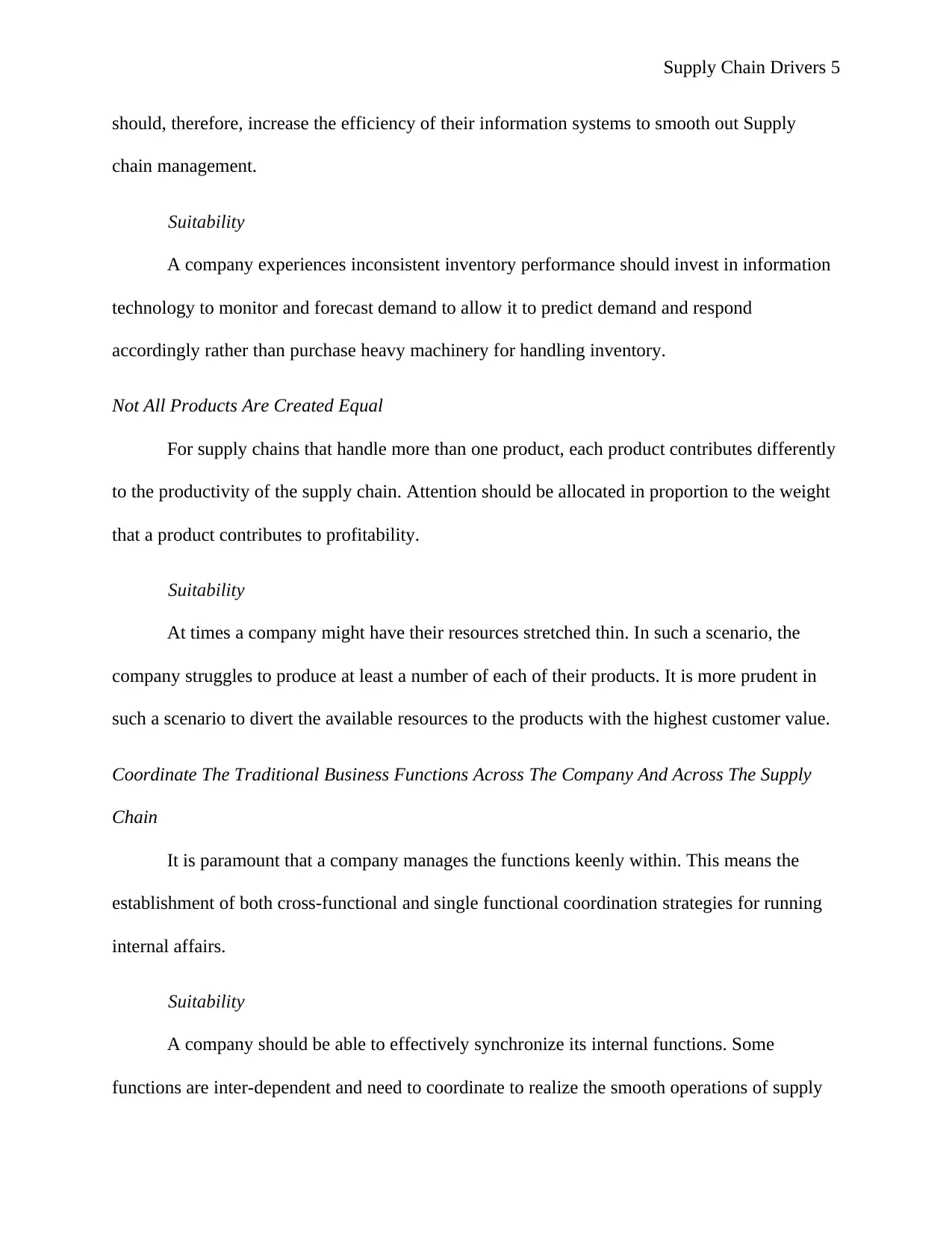
Supply Chain Drivers 5
should, therefore, increase the efficiency of their information systems to smooth out Supply
chain management.
Suitability
A company experiences inconsistent inventory performance should invest in information
technology to monitor and forecast demand to allow it to predict demand and respond
accordingly rather than purchase heavy machinery for handling inventory.
Not All Products Are Created Equal
For supply chains that handle more than one product, each product contributes differently
to the productivity of the supply chain. Attention should be allocated in proportion to the weight
that a product contributes to profitability.
Suitability
At times a company might have their resources stretched thin. In such a scenario, the
company struggles to produce at least a number of each of their products. It is more prudent in
such a scenario to divert the available resources to the products with the highest customer value.
Coordinate The Traditional Business Functions Across The Company And Across The Supply
Chain
It is paramount that a company manages the functions keenly within. This means the
establishment of both cross-functional and single functional coordination strategies for running
internal affairs.
Suitability
A company should be able to effectively synchronize its internal functions. Some
functions are inter-dependent and need to coordinate to realize the smooth operations of supply
should, therefore, increase the efficiency of their information systems to smooth out Supply
chain management.
Suitability
A company experiences inconsistent inventory performance should invest in information
technology to monitor and forecast demand to allow it to predict demand and respond
accordingly rather than purchase heavy machinery for handling inventory.
Not All Products Are Created Equal
For supply chains that handle more than one product, each product contributes differently
to the productivity of the supply chain. Attention should be allocated in proportion to the weight
that a product contributes to profitability.
Suitability
At times a company might have their resources stretched thin. In such a scenario, the
company struggles to produce at least a number of each of their products. It is more prudent in
such a scenario to divert the available resources to the products with the highest customer value.
Coordinate The Traditional Business Functions Across The Company And Across The Supply
Chain
It is paramount that a company manages the functions keenly within. This means the
establishment of both cross-functional and single functional coordination strategies for running
internal affairs.
Suitability
A company should be able to effectively synchronize its internal functions. Some
functions are inter-dependent and need to coordinate to realize the smooth operations of supply
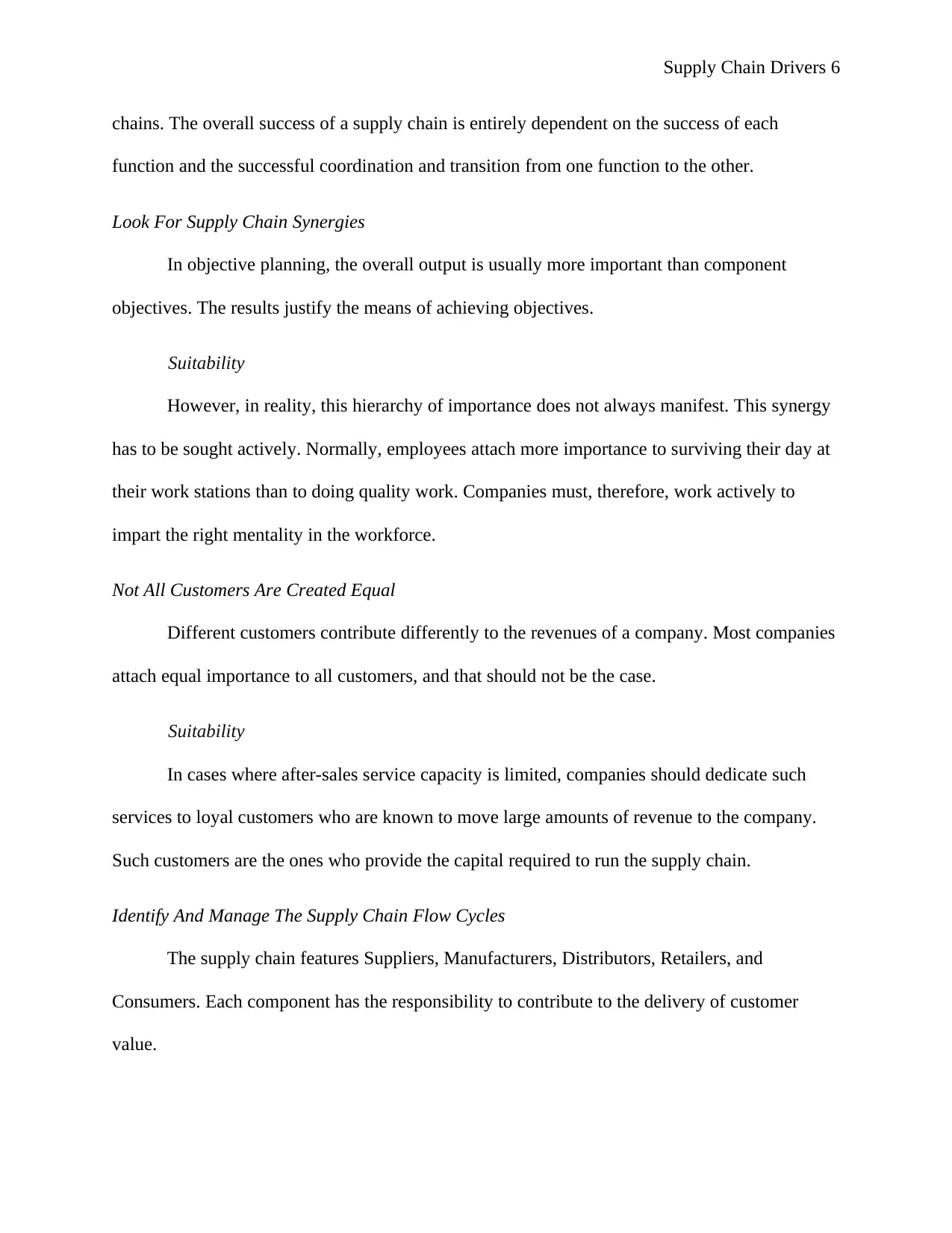
Supply Chain Drivers 6
chains. The overall success of a supply chain is entirely dependent on the success of each
function and the successful coordination and transition from one function to the other.
Look For Supply Chain Synergies
In objective planning, the overall output is usually more important than component
objectives. The results justify the means of achieving objectives.
Suitability
However, in reality, this hierarchy of importance does not always manifest. This synergy
has to be sought actively. Normally, employees attach more importance to surviving their day at
their work stations than to doing quality work. Companies must, therefore, work actively to
impart the right mentality in the workforce.
Not All Customers Are Created Equal
Different customers contribute differently to the revenues of a company. Most companies
attach equal importance to all customers, and that should not be the case.
Suitability
In cases where after-sales service capacity is limited, companies should dedicate such
services to loyal customers who are known to move large amounts of revenue to the company.
Such customers are the ones who provide the capital required to run the supply chain.
Identify And Manage The Supply Chain Flow Cycles
The supply chain features Suppliers, Manufacturers, Distributors, Retailers, and
Consumers. Each component has the responsibility to contribute to the delivery of customer
value.
chains. The overall success of a supply chain is entirely dependent on the success of each
function and the successful coordination and transition from one function to the other.
Look For Supply Chain Synergies
In objective planning, the overall output is usually more important than component
objectives. The results justify the means of achieving objectives.
Suitability
However, in reality, this hierarchy of importance does not always manifest. This synergy
has to be sought actively. Normally, employees attach more importance to surviving their day at
their work stations than to doing quality work. Companies must, therefore, work actively to
impart the right mentality in the workforce.
Not All Customers Are Created Equal
Different customers contribute differently to the revenues of a company. Most companies
attach equal importance to all customers, and that should not be the case.
Suitability
In cases where after-sales service capacity is limited, companies should dedicate such
services to loyal customers who are known to move large amounts of revenue to the company.
Such customers are the ones who provide the capital required to run the supply chain.
Identify And Manage The Supply Chain Flow Cycles
The supply chain features Suppliers, Manufacturers, Distributors, Retailers, and
Consumers. Each component has the responsibility to contribute to the delivery of customer
value.
⊘ This is a preview!⊘
Do you want full access?
Subscribe today to unlock all pages.

Trusted by 1+ million students worldwide
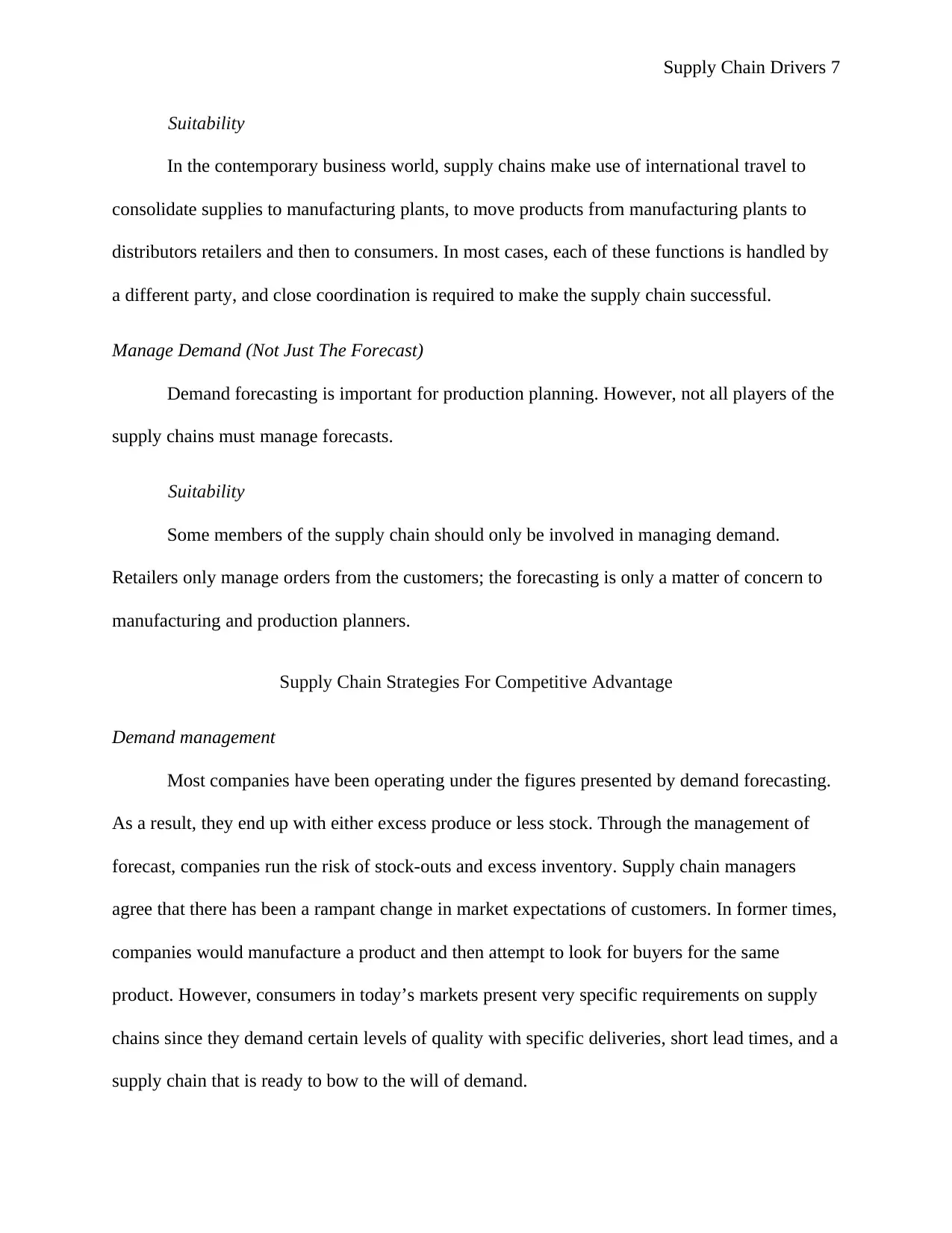
Supply Chain Drivers 7
Suitability
In the contemporary business world, supply chains make use of international travel to
consolidate supplies to manufacturing plants, to move products from manufacturing plants to
distributors retailers and then to consumers. In most cases, each of these functions is handled by
a different party, and close coordination is required to make the supply chain successful.
Manage Demand (Not Just The Forecast)
Demand forecasting is important for production planning. However, not all players of the
supply chains must manage forecasts.
Suitability
Some members of the supply chain should only be involved in managing demand.
Retailers only manage orders from the customers; the forecasting is only a matter of concern to
manufacturing and production planners.
Supply Chain Strategies For Competitive Advantage
Demand management
Most companies have been operating under the figures presented by demand forecasting.
As a result, they end up with either excess produce or less stock. Through the management of
forecast, companies run the risk of stock-outs and excess inventory. Supply chain managers
agree that there has been a rampant change in market expectations of customers. In former times,
companies would manufacture a product and then attempt to look for buyers for the same
product. However, consumers in today’s markets present very specific requirements on supply
chains since they demand certain levels of quality with specific deliveries, short lead times, and a
supply chain that is ready to bow to the will of demand.
Suitability
In the contemporary business world, supply chains make use of international travel to
consolidate supplies to manufacturing plants, to move products from manufacturing plants to
distributors retailers and then to consumers. In most cases, each of these functions is handled by
a different party, and close coordination is required to make the supply chain successful.
Manage Demand (Not Just The Forecast)
Demand forecasting is important for production planning. However, not all players of the
supply chains must manage forecasts.
Suitability
Some members of the supply chain should only be involved in managing demand.
Retailers only manage orders from the customers; the forecasting is only a matter of concern to
manufacturing and production planners.
Supply Chain Strategies For Competitive Advantage
Demand management
Most companies have been operating under the figures presented by demand forecasting.
As a result, they end up with either excess produce or less stock. Through the management of
forecast, companies run the risk of stock-outs and excess inventory. Supply chain managers
agree that there has been a rampant change in market expectations of customers. In former times,
companies would manufacture a product and then attempt to look for buyers for the same
product. However, consumers in today’s markets present very specific requirements on supply
chains since they demand certain levels of quality with specific deliveries, short lead times, and a
supply chain that is ready to bow to the will of demand.
Paraphrase This Document
Need a fresh take? Get an instant paraphrase of this document with our AI Paraphraser
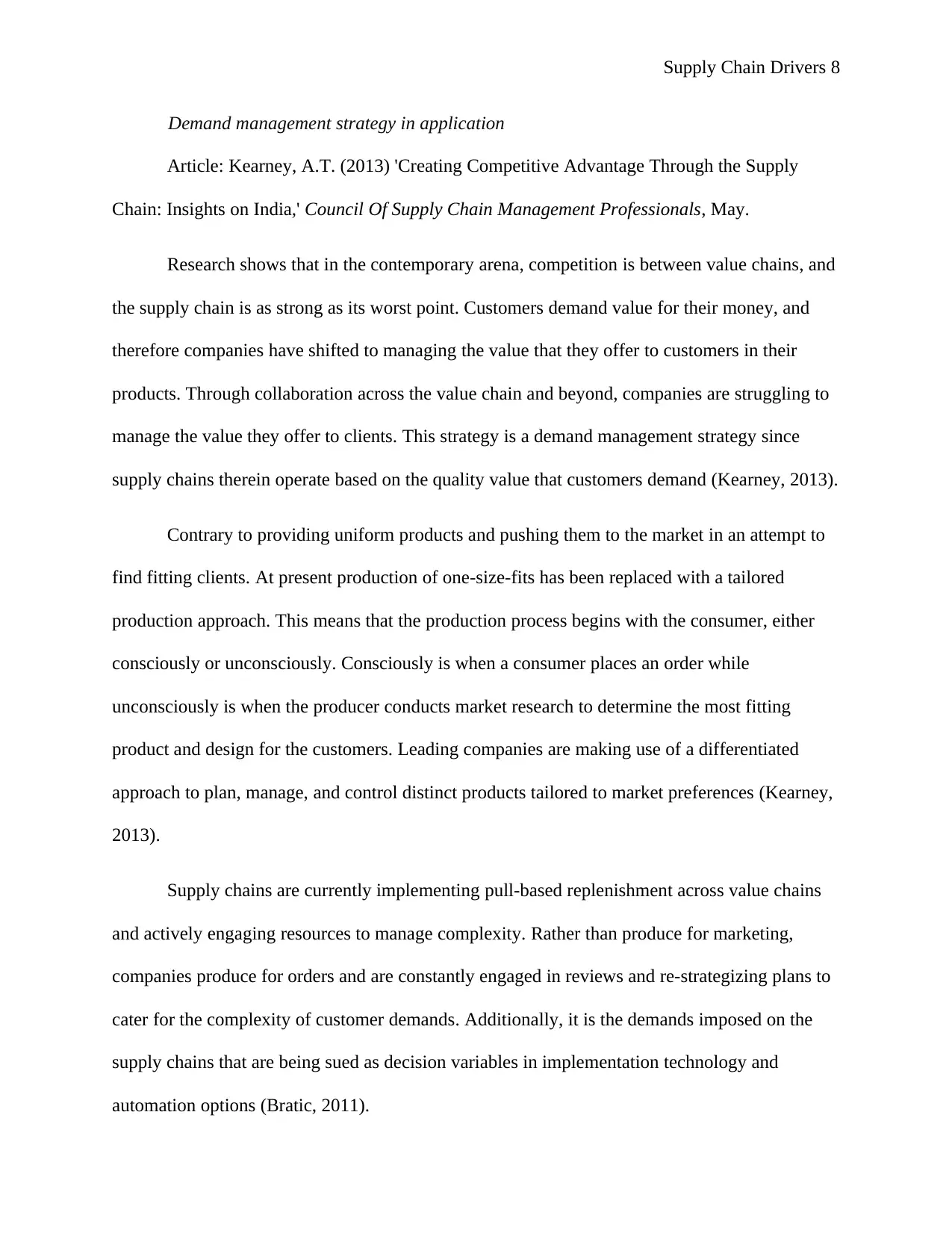
Supply Chain Drivers 8
Demand management strategy in application
Article: Kearney, A.T. (2013) 'Creating Competitive Advantage Through the Supply
Chain: Insights on India,' Council Of Supply Chain Management Professionals, May.
Research shows that in the contemporary arena, competition is between value chains, and
the supply chain is as strong as its worst point. Customers demand value for their money, and
therefore companies have shifted to managing the value that they offer to customers in their
products. Through collaboration across the value chain and beyond, companies are struggling to
manage the value they offer to clients. This strategy is a demand management strategy since
supply chains therein operate based on the quality value that customers demand (Kearney, 2013).
Contrary to providing uniform products and pushing them to the market in an attempt to
find fitting clients. At present production of one-size-fits has been replaced with a tailored
production approach. This means that the production process begins with the consumer, either
consciously or unconsciously. Consciously is when a consumer places an order while
unconsciously is when the producer conducts market research to determine the most fitting
product and design for the customers. Leading companies are making use of a differentiated
approach to plan, manage, and control distinct products tailored to market preferences (Kearney,
2013).
Supply chains are currently implementing pull-based replenishment across value chains
and actively engaging resources to manage complexity. Rather than produce for marketing,
companies produce for orders and are constantly engaged in reviews and re-strategizing plans to
cater for the complexity of customer demands. Additionally, it is the demands imposed on the
supply chains that are being sued as decision variables in implementation technology and
automation options (Bratic, 2011).
Demand management strategy in application
Article: Kearney, A.T. (2013) 'Creating Competitive Advantage Through the Supply
Chain: Insights on India,' Council Of Supply Chain Management Professionals, May.
Research shows that in the contemporary arena, competition is between value chains, and
the supply chain is as strong as its worst point. Customers demand value for their money, and
therefore companies have shifted to managing the value that they offer to customers in their
products. Through collaboration across the value chain and beyond, companies are struggling to
manage the value they offer to clients. This strategy is a demand management strategy since
supply chains therein operate based on the quality value that customers demand (Kearney, 2013).
Contrary to providing uniform products and pushing them to the market in an attempt to
find fitting clients. At present production of one-size-fits has been replaced with a tailored
production approach. This means that the production process begins with the consumer, either
consciously or unconsciously. Consciously is when a consumer places an order while
unconsciously is when the producer conducts market research to determine the most fitting
product and design for the customers. Leading companies are making use of a differentiated
approach to plan, manage, and control distinct products tailored to market preferences (Kearney,
2013).
Supply chains are currently implementing pull-based replenishment across value chains
and actively engaging resources to manage complexity. Rather than produce for marketing,
companies produce for orders and are constantly engaged in reviews and re-strategizing plans to
cater for the complexity of customer demands. Additionally, it is the demands imposed on the
supply chains that are being sued as decision variables in implementation technology and
automation options (Bratic, 2011).
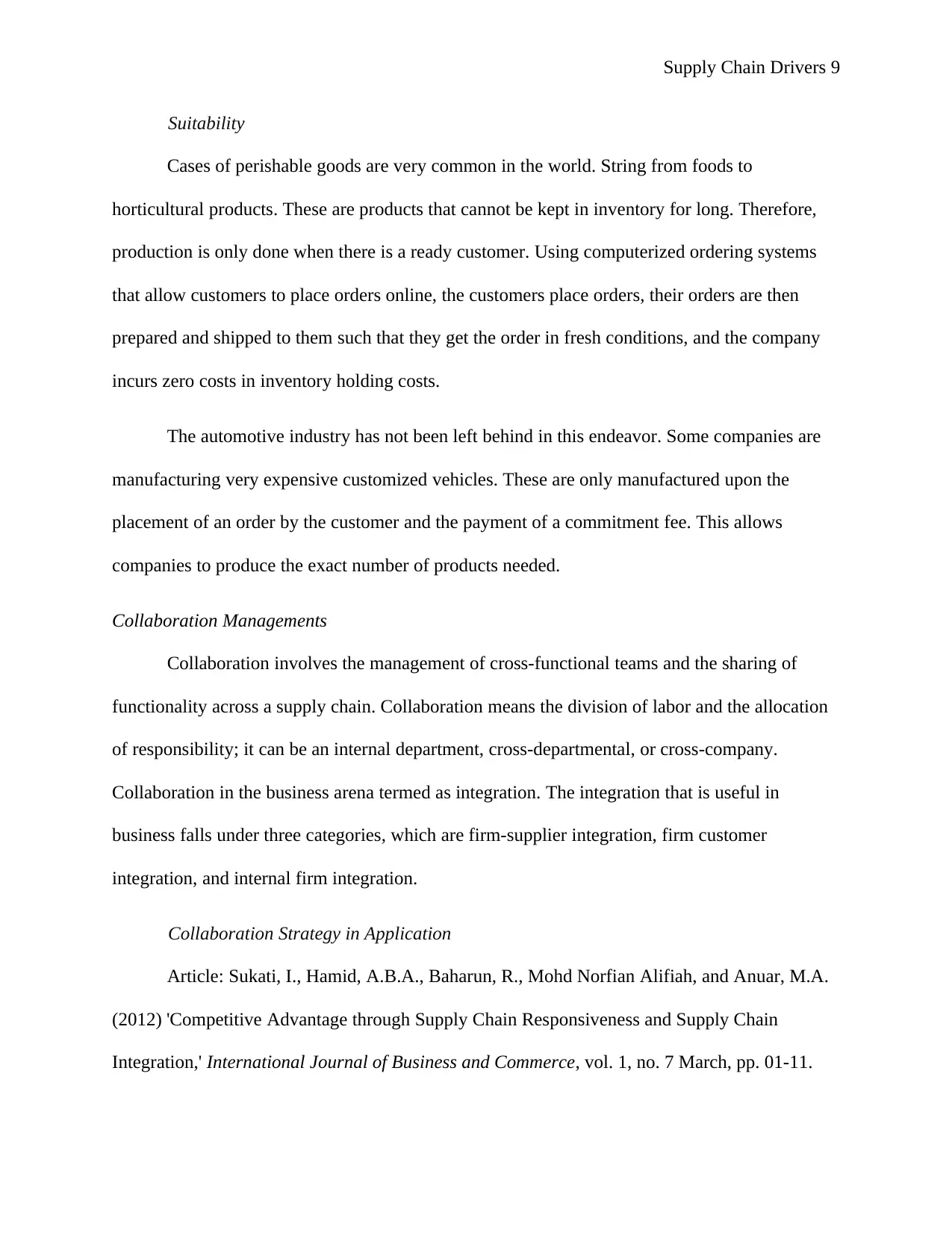
Supply Chain Drivers 9
Suitability
Cases of perishable goods are very common in the world. String from foods to
horticultural products. These are products that cannot be kept in inventory for long. Therefore,
production is only done when there is a ready customer. Using computerized ordering systems
that allow customers to place orders online, the customers place orders, their orders are then
prepared and shipped to them such that they get the order in fresh conditions, and the company
incurs zero costs in inventory holding costs.
The automotive industry has not been left behind in this endeavor. Some companies are
manufacturing very expensive customized vehicles. These are only manufactured upon the
placement of an order by the customer and the payment of a commitment fee. This allows
companies to produce the exact number of products needed.
Collaboration Managements
Collaboration involves the management of cross-functional teams and the sharing of
functionality across a supply chain. Collaboration means the division of labor and the allocation
of responsibility; it can be an internal department, cross-departmental, or cross-company.
Collaboration in the business arena termed as integration. The integration that is useful in
business falls under three categories, which are firm-supplier integration, firm customer
integration, and internal firm integration.
Collaboration Strategy in Application
Article: Sukati, I., Hamid, A.B.A., Baharun, R., Mohd Norfian Alifiah, and Anuar, M.A.
(2012) 'Competitive Advantage through Supply Chain Responsiveness and Supply Chain
Integration,' International Journal of Business and Commerce, vol. 1, no. 7 March, pp. 01-11.
Suitability
Cases of perishable goods are very common in the world. String from foods to
horticultural products. These are products that cannot be kept in inventory for long. Therefore,
production is only done when there is a ready customer. Using computerized ordering systems
that allow customers to place orders online, the customers place orders, their orders are then
prepared and shipped to them such that they get the order in fresh conditions, and the company
incurs zero costs in inventory holding costs.
The automotive industry has not been left behind in this endeavor. Some companies are
manufacturing very expensive customized vehicles. These are only manufactured upon the
placement of an order by the customer and the payment of a commitment fee. This allows
companies to produce the exact number of products needed.
Collaboration Managements
Collaboration involves the management of cross-functional teams and the sharing of
functionality across a supply chain. Collaboration means the division of labor and the allocation
of responsibility; it can be an internal department, cross-departmental, or cross-company.
Collaboration in the business arena termed as integration. The integration that is useful in
business falls under three categories, which are firm-supplier integration, firm customer
integration, and internal firm integration.
Collaboration Strategy in Application
Article: Sukati, I., Hamid, A.B.A., Baharun, R., Mohd Norfian Alifiah, and Anuar, M.A.
(2012) 'Competitive Advantage through Supply Chain Responsiveness and Supply Chain
Integration,' International Journal of Business and Commerce, vol. 1, no. 7 March, pp. 01-11.
⊘ This is a preview!⊘
Do you want full access?
Subscribe today to unlock all pages.

Trusted by 1+ million students worldwide
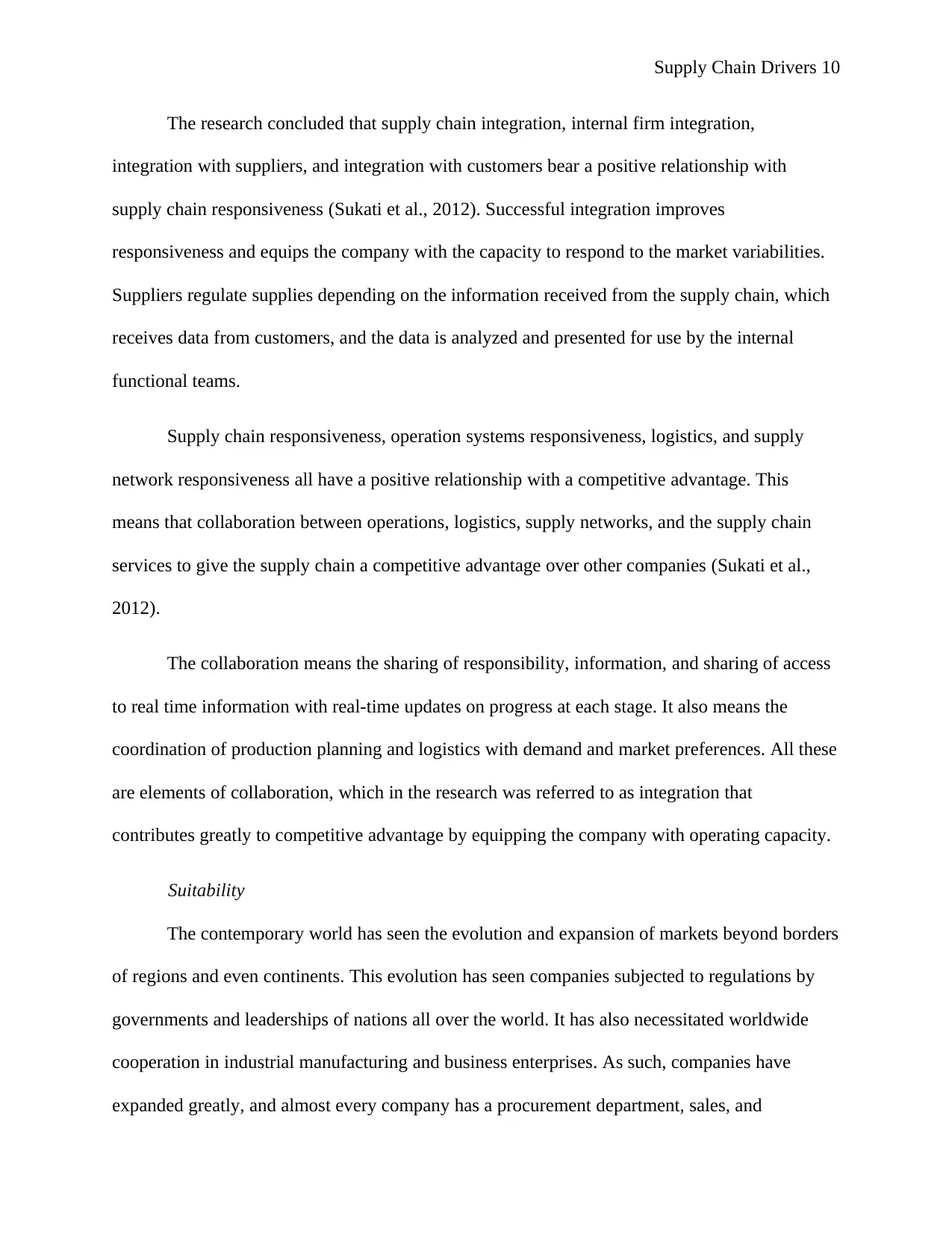
Supply Chain Drivers 10
The research concluded that supply chain integration, internal firm integration,
integration with suppliers, and integration with customers bear a positive relationship with
supply chain responsiveness (Sukati et al., 2012). Successful integration improves
responsiveness and equips the company with the capacity to respond to the market variabilities.
Suppliers regulate supplies depending on the information received from the supply chain, which
receives data from customers, and the data is analyzed and presented for use by the internal
functional teams.
Supply chain responsiveness, operation systems responsiveness, logistics, and supply
network responsiveness all have a positive relationship with a competitive advantage. This
means that collaboration between operations, logistics, supply networks, and the supply chain
services to give the supply chain a competitive advantage over other companies (Sukati et al.,
2012).
The collaboration means the sharing of responsibility, information, and sharing of access
to real time information with real-time updates on progress at each stage. It also means the
coordination of production planning and logistics with demand and market preferences. All these
are elements of collaboration, which in the research was referred to as integration that
contributes greatly to competitive advantage by equipping the company with operating capacity.
Suitability
The contemporary world has seen the evolution and expansion of markets beyond borders
of regions and even continents. This evolution has seen companies subjected to regulations by
governments and leaderships of nations all over the world. It has also necessitated worldwide
cooperation in industrial manufacturing and business enterprises. As such, companies have
expanded greatly, and almost every company has a procurement department, sales, and
The research concluded that supply chain integration, internal firm integration,
integration with suppliers, and integration with customers bear a positive relationship with
supply chain responsiveness (Sukati et al., 2012). Successful integration improves
responsiveness and equips the company with the capacity to respond to the market variabilities.
Suppliers regulate supplies depending on the information received from the supply chain, which
receives data from customers, and the data is analyzed and presented for use by the internal
functional teams.
Supply chain responsiveness, operation systems responsiveness, logistics, and supply
network responsiveness all have a positive relationship with a competitive advantage. This
means that collaboration between operations, logistics, supply networks, and the supply chain
services to give the supply chain a competitive advantage over other companies (Sukati et al.,
2012).
The collaboration means the sharing of responsibility, information, and sharing of access
to real time information with real-time updates on progress at each stage. It also means the
coordination of production planning and logistics with demand and market preferences. All these
are elements of collaboration, which in the research was referred to as integration that
contributes greatly to competitive advantage by equipping the company with operating capacity.
Suitability
The contemporary world has seen the evolution and expansion of markets beyond borders
of regions and even continents. This evolution has seen companies subjected to regulations by
governments and leaderships of nations all over the world. It has also necessitated worldwide
cooperation in industrial manufacturing and business enterprises. As such, companies have
expanded greatly, and almost every company has a procurement department, sales, and
Paraphrase This Document
Need a fresh take? Get an instant paraphrase of this document with our AI Paraphraser
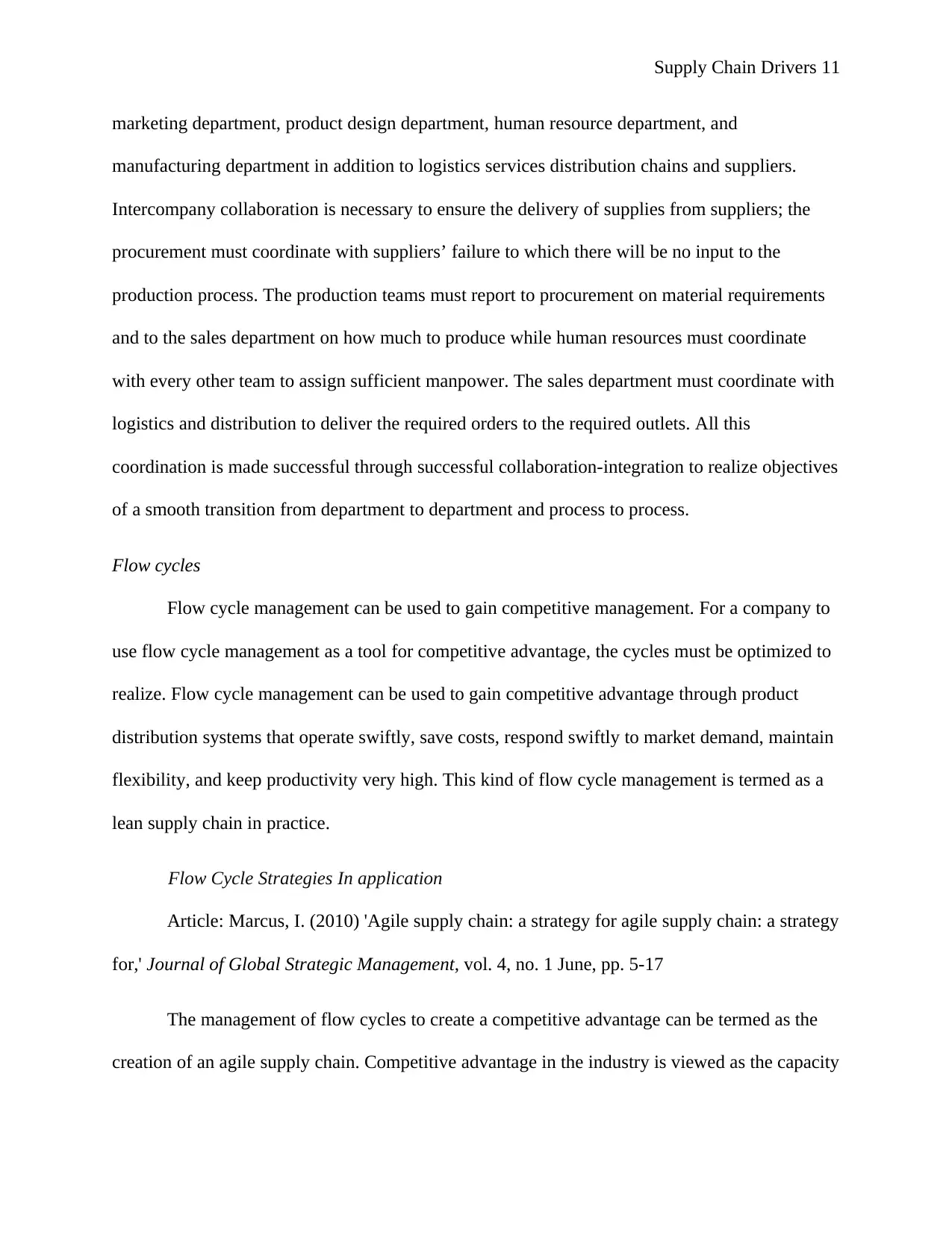
Supply Chain Drivers 11
marketing department, product design department, human resource department, and
manufacturing department in addition to logistics services distribution chains and suppliers.
Intercompany collaboration is necessary to ensure the delivery of supplies from suppliers; the
procurement must coordinate with suppliers’ failure to which there will be no input to the
production process. The production teams must report to procurement on material requirements
and to the sales department on how much to produce while human resources must coordinate
with every other team to assign sufficient manpower. The sales department must coordinate with
logistics and distribution to deliver the required orders to the required outlets. All this
coordination is made successful through successful collaboration-integration to realize objectives
of a smooth transition from department to department and process to process.
Flow cycles
Flow cycle management can be used to gain competitive management. For a company to
use flow cycle management as a tool for competitive advantage, the cycles must be optimized to
realize. Flow cycle management can be used to gain competitive advantage through product
distribution systems that operate swiftly, save costs, respond swiftly to market demand, maintain
flexibility, and keep productivity very high. This kind of flow cycle management is termed as a
lean supply chain in practice.
Flow Cycle Strategies In application
Article: Marcus, I. (2010) 'Agile supply chain: a strategy for agile supply chain: a strategy
for,' Journal of Global Strategic Management, vol. 4, no. 1 June, pp. 5-17
The management of flow cycles to create a competitive advantage can be termed as the
creation of an agile supply chain. Competitive advantage in the industry is viewed as the capacity
marketing department, product design department, human resource department, and
manufacturing department in addition to logistics services distribution chains and suppliers.
Intercompany collaboration is necessary to ensure the delivery of supplies from suppliers; the
procurement must coordinate with suppliers’ failure to which there will be no input to the
production process. The production teams must report to procurement on material requirements
and to the sales department on how much to produce while human resources must coordinate
with every other team to assign sufficient manpower. The sales department must coordinate with
logistics and distribution to deliver the required orders to the required outlets. All this
coordination is made successful through successful collaboration-integration to realize objectives
of a smooth transition from department to department and process to process.
Flow cycles
Flow cycle management can be used to gain competitive management. For a company to
use flow cycle management as a tool for competitive advantage, the cycles must be optimized to
realize. Flow cycle management can be used to gain competitive advantage through product
distribution systems that operate swiftly, save costs, respond swiftly to market demand, maintain
flexibility, and keep productivity very high. This kind of flow cycle management is termed as a
lean supply chain in practice.
Flow Cycle Strategies In application
Article: Marcus, I. (2010) 'Agile supply chain: a strategy for agile supply chain: a strategy
for,' Journal of Global Strategic Management, vol. 4, no. 1 June, pp. 5-17
The management of flow cycles to create a competitive advantage can be termed as the
creation of an agile supply chain. Competitive advantage in the industry is viewed as the capacity
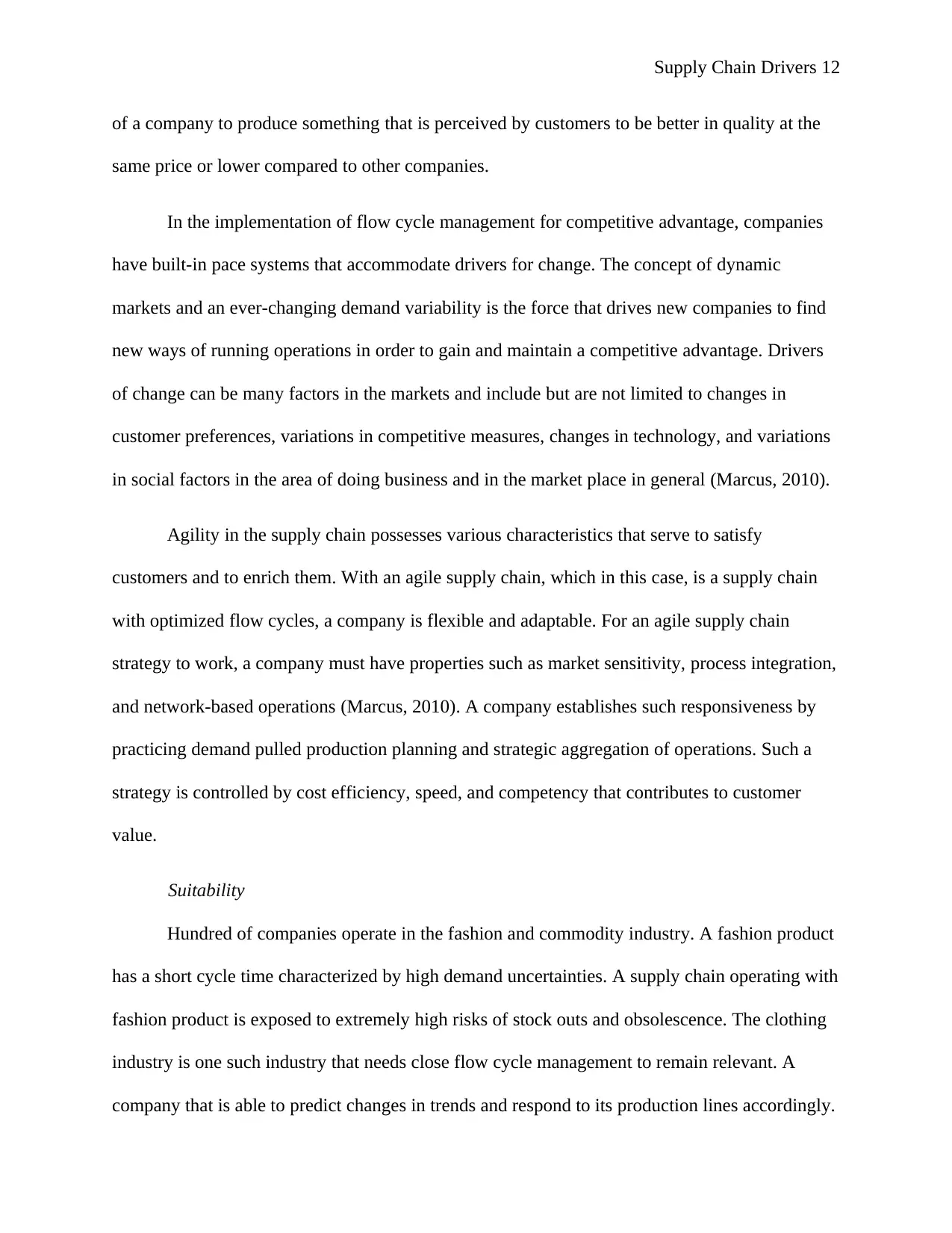
Supply Chain Drivers 12
of a company to produce something that is perceived by customers to be better in quality at the
same price or lower compared to other companies.
In the implementation of flow cycle management for competitive advantage, companies
have built-in pace systems that accommodate drivers for change. The concept of dynamic
markets and an ever-changing demand variability is the force that drives new companies to find
new ways of running operations in order to gain and maintain a competitive advantage. Drivers
of change can be many factors in the markets and include but are not limited to changes in
customer preferences, variations in competitive measures, changes in technology, and variations
in social factors in the area of doing business and in the market place in general (Marcus, 2010).
Agility in the supply chain possesses various characteristics that serve to satisfy
customers and to enrich them. With an agile supply chain, which in this case, is a supply chain
with optimized flow cycles, a company is flexible and adaptable. For an agile supply chain
strategy to work, a company must have properties such as market sensitivity, process integration,
and network-based operations (Marcus, 2010). A company establishes such responsiveness by
practicing demand pulled production planning and strategic aggregation of operations. Such a
strategy is controlled by cost efficiency, speed, and competency that contributes to customer
value.
Suitability
Hundred of companies operate in the fashion and commodity industry. A fashion product
has a short cycle time characterized by high demand uncertainties. A supply chain operating with
fashion product is exposed to extremely high risks of stock outs and obsolescence. The clothing
industry is one such industry that needs close flow cycle management to remain relevant. A
company that is able to predict changes in trends and respond to its production lines accordingly.
of a company to produce something that is perceived by customers to be better in quality at the
same price or lower compared to other companies.
In the implementation of flow cycle management for competitive advantage, companies
have built-in pace systems that accommodate drivers for change. The concept of dynamic
markets and an ever-changing demand variability is the force that drives new companies to find
new ways of running operations in order to gain and maintain a competitive advantage. Drivers
of change can be many factors in the markets and include but are not limited to changes in
customer preferences, variations in competitive measures, changes in technology, and variations
in social factors in the area of doing business and in the market place in general (Marcus, 2010).
Agility in the supply chain possesses various characteristics that serve to satisfy
customers and to enrich them. With an agile supply chain, which in this case, is a supply chain
with optimized flow cycles, a company is flexible and adaptable. For an agile supply chain
strategy to work, a company must have properties such as market sensitivity, process integration,
and network-based operations (Marcus, 2010). A company establishes such responsiveness by
practicing demand pulled production planning and strategic aggregation of operations. Such a
strategy is controlled by cost efficiency, speed, and competency that contributes to customer
value.
Suitability
Hundred of companies operate in the fashion and commodity industry. A fashion product
has a short cycle time characterized by high demand uncertainties. A supply chain operating with
fashion product is exposed to extremely high risks of stock outs and obsolescence. The clothing
industry is one such industry that needs close flow cycle management to remain relevant. A
company that is able to predict changes in trends and respond to its production lines accordingly.
⊘ This is a preview!⊘
Do you want full access?
Subscribe today to unlock all pages.

Trusted by 1+ million students worldwide
1 out of 14
Related Documents
Your All-in-One AI-Powered Toolkit for Academic Success.
+13062052269
info@desklib.com
Available 24*7 on WhatsApp / Email
![[object Object]](/_next/static/media/star-bottom.7253800d.svg)
Unlock your academic potential
Copyright © 2020–2025 A2Z Services. All Rights Reserved. Developed and managed by ZUCOL.




